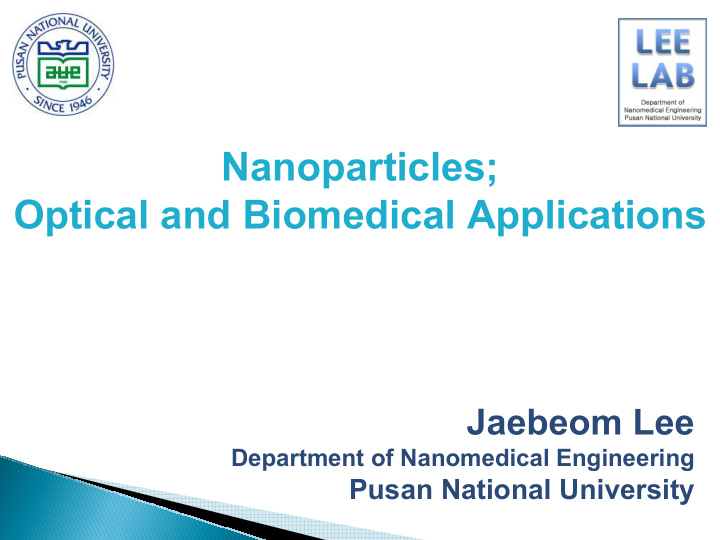



Nanoparticles; Optical and Biomedical Applications Jaebeom Lee Department of Nanomedical Engineering Pusan National University
Re-construction Nanomaterials assemblies • Expected better or novel optical properties of combined nano-hybrids Individual • Customized optical and electromagnetic properties of nanomaterials Combination to have Function • Possibly advanced nano devices application for environmental and bio-sensing, solar cell, photovoltaics, imaging, non-linearity, photonics, optoelectronics, etc.
Stabilizers - Water-based Synthesis - Control the sizes of NP NP - Easy to bind other materials Nanoparticles, Nanorods - CdTe, CdSe, CdS, HgTe - Au, Ag
Nanoparticle � Nanowires Strong Luminescence Aqueous Dispersions Quantum yield 29% Quantum yield 16% Quantum yield 6% Quantum yield 2.3% Z. Tang, N. A. Kotov, M. Giersig. Science 2002 , 297 , 273.
Immobilization EDC : 1-ethyl-3-(3-dimethlamino propyl) carbodiimide hydrochloride Sulfo-NHS : N-hydroxy-sulfosuccinimide CdTe NW-Biotin Centrifuge EDC, Sulfo-NHS NP or 6000 rpm, 10 NP or NW min, 3 times Biotin Au or CdTe NP-Streptavidin HS(CH2)2CH3 : HS(CH2)2COOH (3:1) EDC, Sulfo-NHS Centrifuge 24 hrs stirring 6000 rpm, 10 min, 3 times SA Biotin Au NP
Luminescence Enhancement via Nanowires and Au Nanoparticles Assembles 1.6 5 A 65 min PL B 40 min Excitation 1.4 4 NW-biotin 30 min (420 nm) 1.2 PL Intensity 1.0 3 8 NW 2 2 min 6 NW-biotin only 4 1 SA-B 2 0 0 550 600 650 700 750 800 550 600 650 700 750 800 Au NP Wavelength (nm) Wavelength (nm) 689 nm A: NW-Biotin with Streptavidin B: NW-Biotin with Au-Streptavidin 5-fold A B Microscopic PL images enhancement 001 100 Before conjugation After conjugation J Lee, Nano Lett.; 2004 ; 4 (12); 2323-2330
CdT e PEG ( ∆ r ) Au sec Stretch! sec Depending on Temperature Temperature oscillations result in emission modulation
Sensing is based on wavelength shift of the emission intensity Not on the intensity change No need for internal Tunable wavelengths Robust operation standards Litmus paper technology for biosensors J. Lee, Nature Materials , Apr. 2007
One probable reason: The local surface of NW is not flat, inducing different band gaps.
� Interdisciplinary study is necessary to develop novel nanoscale biomedical sensing/imaging devices � The superstructures using polymer/ bio- affinity and nanomaterials have strong potential for future sensing/imaging devices
Academic Collaboration Nicholas A. Kotov U of Michigan Alexander O. Govorov Ohio Uni. Zhiyong Tang Peking Univ. Prof. K.N. Koh Nanomedical Dept. , PNU Prof. S.H. Jin Chem. & Edu. Dept. Prof. S.C. Ryu Nanomaterials Dept. Prof. S.H. Kim Nanosystem & Proc. Dept. Prof. C.M. Kim Medical School Graduates Dr Hongxia Chen, Post-doc Fangfang Sun Master degree Undergraduate Assistants Hyung Goo Kang, Sangjun Park, SungHoon Kim, Kyung-Geun Lim Funding Agencies: Industrial Collaboration -New faculty allowance, Pusan National University -2 yr Unassigned Project, Pusan National University -Sungjin J&T, Busan -New Faculty Research Project Award (2 yrs from Aug. 2007), KRF -HAp Inc., Busan -Bone patch development, IGB fraunhoefer JRC -SeedBiochip Inc. Chungju Ochang BT park -Fluorescent NP detector in PCR, IGB fraunhoefer JRC - 3 rd IT research center, MKE -Brain Korea 21 (support stipends of graduates) 11
Recommend
More recommend